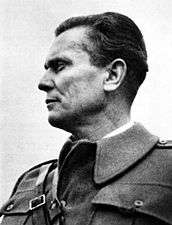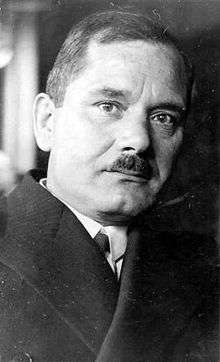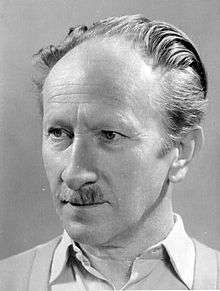Provisional Government of the Democratic Federal Yugoslavia
| Temporary Government of the Democratic Federal Yugoslavia | |
|---|---|
|
| |
 | |
| Date formed | 7 March 1945 |
| Date dissolved | 11 November 1945 |
| People and organisations | |
| Head of government | Josip Broz Tito |
| Head of state | Peter II |
| Status in legislature | Coalition |
| History | |
| Predecessor |
Yugoslav government-in-exile National Committee for the Liberation of Yugoslavia |
| Successor | Socialist Federal Republic of Yugoslavia |

The Temporary Government of the Democratic Federal Yugoslavia (Serbo-Croatian: Privremena vlada Demokratske Federativne Jugoslavije / Привремена влада Демократске Федеративне Југославије) was the state's temporary national government formed through the merger of the Yugoslav government-in-exile and the National Committee for the Liberation of Yugoslavia (NKOJ). It existed from 7 March to 11 November 1945. It then became the Socialist Federal Republic of Yugoslavia from 1945 to 1992.
History
"At the moment these are our efforts are focused in one direction, and that is:
- to bring together all patriotic and honorable individuals to our fight against the invaders was as successful as possible,
- build the nations Yugoslav brotherhood and unity that did not exist before the war and for whose absence brought our country to disaster
- provide conditions for the organization of a state in which all the nations feel happy, and it is truly a Democratic Federal Yugoslavia."
Emergence
Before the temporary government was formed, there were several meetings between Tito and Ivan Šubašić, the pre-war Ban of Croatia and Prime Minister of Yugoslavia in London during the Second World War.
The international situation has affected Tito to enter politics and compromise to replace radicalism, the pressure of Great Britain and its international protector USSR, "real politics" and to adopt a memorandum of the British government, which was transmitted to him by Winston Churchill of August 1944. To the country will not impose communism, to keep the Communist Party in the conspiracy, and to express the communist program through the National Front of Yugoslavia.
After the Treaty of Vis or the Tito–Šubašić Agreement, Tito and Šubašić met in Vršac on 20 October 1944. Tito's stay in the Soviet Union during the Moscow Conference between Joseph Stalin and Winston Churchill opened the door for other agreements between representatives of the National Committee and the Royal Government. The agreement was concluded on 1 November 1944 in Belgrade and is known as the Belgrade Agreement.
To new contacts occurred in December 1944, when the amendment was made to the Belgrade Agreement, certain guarantees for the political parties, and the ratification of legislation AVNOJ by the future Constituent Assembly. The Belgrade Agreement has been dissatisfied with King Peter II, whose function under the agreement of Tito–Šubašić in 1944. A Regency Council performed by a panel composed of three members.
However, after the Yalta Conference on 16 February 1945, Ivan Šubašić's government arrived in Belgrade. After much negotiation and persuasion, King Peter II finally agreed to power transition. Under the agreement, three days later, the royal government and the NKOJ resigned. The new government was formed on 7 March 1945, and on 9 March adopted a Declaration. That night Tito read it in a broadcast over Radio Belgrade.
Abdication of King Peter II
Acting as Head of state on 7 March 1945, King Peter II created his Regency Council to which he appointed constitutional lawyers Srđan Budisavljević, Ante Mandić and Dušan Sernec. In doing so, the King empowered his Council to form a common temporary government with the National Committee for the Liberation of Yugoslavia (NKOJ) and accept Josip Broz Tito's nomination as Prime Minister of the first normal government of post-war Yugoslavia. As authorized by the King, the Council has thus accepted the Tito's nomination on 29 November 1945, when FNRJ or Second Yugoslavia was officially declared. By this unconditional transfer of powers, Peter II has abdicated to Tito.[1] This date, when the second Yugoslavia was born under international law, had since been marked as Yugoslavia's national holiday Day of the Republic, however following the communists' switch to totalitarianism, this holiday officially marked the 1943 Session of AVNOJ that coincidentally fell on the same day of the year.[2]
Milan Grol the Deputy Prime Minister resigned on 8 August 1945, on the grounds that the new government did not respect the principle of democracy and freedom of speech. After the "burning house" editorial of Democracy was published in the towns of Yugoslavia, there was a disagreement between Šubašić and a representative of the Unitary National Liberation Front. On the same day, Juraj Šutej, Minister without portfolio, resigned. Ivan Šubašić, the Minister of Foreign Affairs, resigned on 8 October 1945, saying there was no free democratic government but a communist dictatorship in the country.
Members of the cabinet
| Name[3] | Portfolio | Party | Note | |
|---|---|---|---|---|
| Josip Broz Tito | Prime Minister, Minister of Defence | Unitary National Liberation Front | ||
| Milan Grol | Deputy Prime Minister | Democratic Party | Resigned on 18 August 1945 | |
| Edvard Kardelj | Deputy Prime Minister, Minister for Constituent | Unitary National Liberation Front | ||
| Ivan Šubašić | Minister of Foreign Affairs | Croatian Peasant Party | Resigned on 8 October 1945 | |
| Josip Smodlaka | Minister without Portfolio | Unitary National Liberation Front | ||
| Juraj Šutej | Minister without Portfolio | Resigned on 18 August 1945 | ||
| Sreten Žujović | Minister of Finances | Unitary National Liberation Front | ||
| Drago Marušić | Minister of Post, Telegraph and Telephone | |||
| Frane Frol | Minister of Justice | Unitary National Liberation Front | ||
| Vlada Zečević | Minister of Internal Affairs | Unitary National Liberation Front | ||
| Todor Vujasinović | Minister of Transport | Unitary National Liberation Front | ||
| Andrija Hebrang | Minister of Industry | Unitary National Liberation Front | ||
| Nikola Petrović | Minister of Trade and Supply | Unitary National Liberation Front | ||
| Vladislav S. Ribnikar | Minister of Education | Unitary National Liberation Front | ||
| Sava Kosanović | Minister of Information | |||
| Zlatan Sremec | Minister of Public Health | |||
| Bane Andrejev | Minister of Mining | Unitary National Liberation Front | ||
| Vaso Čubrilović | Minister of Agriculture | Unitary National Liberation Front | ||
| Sulejman Filipović | Minister of Forestry | Unitary National Liberation Front | ||
| Anton Kržišnik | Minister of Social Affairs | Unitary National Liberation Front | ||
| Sreten Vukosavljević | Minister of Colonization | Unitary National Liberation Front | ||
| Rade Pribićević | Minister of Construction | Unitary National Liberation Front | ||
| Edvard Kocbek | Minister for Slovenia | Unitary National Liberation Front | ||
| Jaša Prodanović | Minister for Serbia | Unitary National Liberation Front | ||
| Rodoljub Čolaković | Minister for Bosnia and Herzegovina | Unitary National Liberation Front | ||
| Milovan Đilas | Minister for Montenegro | Unitary National Liberation Front | ||
| Emanuel Čučkov | Minister for Macedonia | Unitary National Liberation Front | ||
| Pavle Gregorić | Minister for Croatia | Unitary National Liberation Front | ||
Notes
- ↑ Charles D. Pettibone (2014) The organization and order of battle of militaries in World War II, Trafford Publishing, Bloomington, Indiana SAD, p.393.
- ↑ "29 November, Yugoslavia: Day of the Republic", Faculty of Humanities Research Projects page, University of Oslo, Norway. Publication date: 24 August 2008.
- ↑ Petranović, p. 353
References
- Petranović, Branko (1981). Istorija Jugoslavije 1918–1978 (in Serbo-Croatian) (2 ed.). Belgrade: Nolit.
- Šepić, Dragovan (1983). Vlada Ivana Šubašića (in Serbo-Croatian). Zagreb: Globus. Retrieved 25 November 2013.


